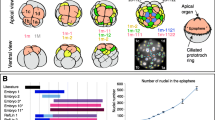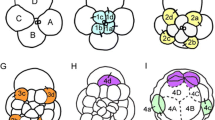Summary
The egg of the polychaete Chætopterus, like many spiralian embryos, undergoes unequal cleavage during the first two cell divisions following fertilization. The first cleavage gives rise to a large CD blastomere and a smaller AB blastomere. At second cleavage the CD blastomere divides asymmetrically, forming a large D blastomere and a smaller C blastomere while the AB cell divides to give rise to the two smaller blastomeres, A and B, which are virtually identical in size. As in many of the other spiralians which have been studied, the A, B, C, and D blastomeres give rise to characteristic portions of the larval body plan. It has been shown in these related forms that the D blastomere derivatives are necessary for the production of various structures derived from the remaining three quadrants, as well as in organizing the overall symmetry properties of the embryo. If Chætopterus embryos are compressed underneath a coverslip at the appropriate stage of development prior to first cleavage (the “pear stage”) some of the embryos divide to form two equal sized blastomeres. Each of the two cells in equalized embryos appears to develop as a normal CD blastomere often dividing to generate a four-celled embryo with two C and two D blastomeres opposite one another (CDCD embryos). These embryos often grow up to form larvae which have duplicated structures. We investigated the role of the early cleavage program in the production of double larvae by staining individual blastomeres of normal and equalized embryos with Nile blue sulfate. Our results reveal that previous descriptions of the symmetry properties of twinned larvae are incorrect. Twins are not true Janus larvae of the duplicitus cruciata form but are organized along a single axis. The two halves face one another along a plane of mirror symmetry, each one fused to the other at their ventral surface just above a single, common, fused mouth. Furthermore, the median plane of the two fused heads is the same as that of the two trunks. These labeling studies indicate that cells derived from both of the two C blastomeres in compressed embyos contribute to the formation of similar structures in both halves of the double larva. The two C quadrants within the double embryos each can give rise to two eyes, and the plane of mirror symmetry between the two halves of the double embryo as mentioned above corresponds to a plane running through the two C blastomeres in the fourcelled CDCD embryo. These findings indicate that the two D quadrants in these double embryos interact to organize the development of the double embryo in a coordinating manner. Both D quadrants, therefore, appear to be inductively active within the CDCD double embryos. These results are discussed in view of various hypotheses which have been proposed to explain the phenomenon of twinning in spiralians.
Similar content being viewed by others
References
Atkinson JW (1971) Organogenesis in normal and lobeless embryos of the marine prosobranch Ilyanassa obsoleta. J Morphol 133:339–352
Cather JN (1967) Cellular interactions in the development of the shell gland of the gastropod Ilyanassa. J Exp Zool 166:205–224
Cather JN (1971) Cellular interactions in the regulation of development in annelids and molluscs. Adv Morphogen 9:67–125
Cather JN, Verdonk NH (1974) The development of Bithynia tentaculata (Prosobranchia, Gastropoda) after removal of the polar lobe. J Embryol Exp Morphol 31:415–422
Cather JN, Verdonk NH (1979) Development of Dentalium following the removal of D-quadrant blastomeres at successive cleavage stages. Wilhelm Roux's Arch 187:355–366
Cather JN, Verdonk NH, Dohmen MR (1976a) Role of the vegetal body in the regulation of development in Bithynia tentaculata (Prosobranchia, Gastropoda). Am Zool 16:455–468
Cather JN, Verdonk NH, Zwaan G (1976b) Cellular interactions in the early development of the gastropod eye, as determined by deletion experiments. Malacol Rev 9:77–84
Clement AC (1952) Experimental studies on germinal localization in Ilyanassa. I. The role of the polar lobe in determination of the cleavage pattern and its influence on later development. J Exp Zool 121:563–626
Clement AC (1956) Experimental studies on germinal localization in Ilyanassa. II. The development of isolated blastomeres. J Exp Zool 132:427–446
Clement AC (1962) Development of Ilyanassa following removal of the D macromere at successive cleavage stages. J Exp Zool 149:193–216
Clement AC (1967) The embryonic value of the micromeres in Ilyanassa obsoleta as determined by deletion experiments. I. The first quartet cells. J Exp Zool 166:77–88
Clement AC (1976) Cell determination and organogenesis in molluscan development: A reappraisal based on deletion experiments in Ilyanassa. Am Zool 16:447–453
Costello DP, Henley C (1976) Spiralian development: a prospective. Am Zool 16:277–291
Crampton HE (1896) Experimental studies on gastropod development. Roux's Arch Dev Biol 3:1–19
Dorresteijn AWC, Borneswasser H, Fischer A (1987) A correlative study of experimentally changed first cleavage and Janus development in the trunk of Platynereis dumerilii (Annelida, Polychaeta). Roux's Arch Dev Biol 196:51–58
Enders HE (1909) A study of the life history and habits of Chætopterus variopedatus, Renier et Clapareda. J Morphol 20:479–532
Freeman G, Reynolds GT, Walton A (1974) The development of light production in the annelid Chætopterus pergamentaceus. Biol Bull 147:477
Guerrier P (1970a) Les characteres de la segmentation et la détermination de la polarité dorsoventrale dans le developpement de quelques spiralia. III. Sabellaria alveolata (Annélide polychète). J Embryol Exp Morphol 23:639–665
Guerrier P (1970b) Les characteres de la segmentation et la détermination de la polarité dorsoventrale dans le developpement de quelques spiralia. II. Pholas dactylus et Spisula subtruncata (Mollusques Lamellibranches). J Embryol Exp Morphol 23:667–692
Guerrier P, van den Biggelaar JAM, van Dongen CAM, Verdonk NH (1978) Significance of the polar lobe for the determination of dorsoventral polarity in Dentalium vulgare (de Costa). Dev Biol 63:233–242
Hatt P (1932) Essais expérimentaux sur les localizations germinales dans l'oeuf d'un annelide (Sabellaria alveolata L.) Arch d'anat Micros 28:81–98
Henry JJ (1986) The role of unequal cleavage and the polar lobe in the segregation of developmental potential during the first cleavage in the embryo of Chætopterus variopedatus. Roux's Arch Dev Biol 195:103–116
Lillie FR (1906) Observations and experiments concerning the elementary phenomena of embryonic development of Chætopterus. J Exp Zool 3:153–268
Martindale MQ, Doe CQ, Morrill JB (1985) The role of animal-vegetal interaction with respect to the determination of dorsoventral polarity in the equal-cleaving spiralian, Lymnæa palustris. Wilhelm Roux's Arch 194:281–295
Martindale MQ (1986) The organizing role of the D quadrant in an equal-cleaving spiralian, Lymnæa palustris as studied by UV laser deletions of macromeres at intervals between third and fourth quartet formation. Inter J Invert Repro Dev 9:229–242
Mead AD (1895) Some observations on maturation and fecundation in Chætopterus pergamentaceus, Cuv J Morphol 10:313–317
Mead AD (1897) The early development of marine annelids. J Morphol 13:227–326
Mead AD (1898) The origin and behavior of the centrosomes in the annelid egg. J Morphol 14:181–218
Novikoff AB (1938) Embryonic determination in the annelid, Sabellaria vulgaris. II. Transplantation of polar lobes and blastomeres as a test of their inducing capacities. Biol Bull 74:211–234
Novikoff AB (1940) Morphogenetic substances or organizers in annelid development. J Exp Zool 85:127–154
Penners A (1922) Über Doppelbildung bei Tubifex rivulorum. Lam Verh Dtsch Zool Ges 27:46–48
Penners A (1924) Doppelbildung bei Tubifex rivulorum. Zool Jahrb Allg Zool 41:91–120
Rattenbury JC, Berg WE (1954) Embryonic segregation during early development of Mytilus edulis. J Morphol 95:393–414
Render JA (1983) The second polar lobe of the Sabellaria cementarium embryo plays an inhibitory role in apical tuft formation. Wilhelm Roux's Arch 192:120–129
Render J (1986) Equalization of first cleavage in Ilyanassa obsoleta embryos. Biol Bull 171:474
Richardson KC, Jarrett L, Finke EH (1960) Embedding in epon resins for ultrathin sectioning in electron microscopy. Stain Tech 35:313–323
Titlebaum A (1928) Artificial production of janus embryos. PNAS 14:245–247
Tyler A (1930) Experimental production of double embryos in annelids and mollusks. J Exp Zool 57:347–407
van Dam WI, Dohmen MR, Verdonk NH (1982) Localization of morphogenetic determinants in a special cytoplasm present in the polar lobe of Bithynia tentaculata (Gastropoda). Wilhelm Roux's Arch 191:371–377
van den Biggelaar JAM, Guerrier P (1983) Origins of spatial organization. In: Verdonk NH, van den Biggelaar JAM, Tompa AS (eds) The mollusca, vol 3. Academic Press, New York, pp 179–213
van Dongen CAM (1976a) The development of Dentalium with special reference to the significance of the polar lobe. V, VI. Differentiation of the cell pattern in lobeless embryos of Dentalium vulgare (da Costa) during larval development. Proc K Ned Akad Wet [Ser C 79]: 245–266
van Dongen CAM (1976b) The development of Dentalium with special reference to the significance of the polar lobe. VII. Organogenesis and histogenesis in lobeless embryos of Dentalium vulgare (da Costa) as compared to normal development. Proc K Ned Akad Wet [Ser C 79]: 454–465
van Dongen CAM, Geilenkirchen WLM (1975) The development of Dentalium with special reference to the significance of the polar lobe. IV. Division chronology and development of the cell pattern in Dentalium dentale after removal of the polar lobe at first cleavage. Proc K Ned Akad Wet [Ser C 78]: 358–375
Verdonk NH, Cather JN (1983) Morphogenetic determination and differentiation. In: Verdonk NH, van den Biggelaar JAM, Tompa AS (eds) The mollusca, vol 3. Academic Press, New York, pp 215–252
Verdonk NH, van den Biggelaar JAM (1983) The development of isolated blastomeres and the formation of the germ layers. In: Verdonk NH, van den Biggelaar JAM, Tompa AS (eds) The mollusca, vol 3. Academic Press, New York, pp 91–122
Wilson EB (1883) Observations on the early developmental stages of some polychætous annelids. Stud Biol Lab Johns Hopkins University 2:271–299
Wilson EB (1892) The cell lineage of Nereis. J Morphol 6:361–470
Wilson EB (1898) Cell-lineage and ancestral reminiscence. In: Biological lectures of the marine biological laboratory. Woods Hole, Mass., Ginn, Boston: pp 21–42
Wilson EB (1904a) Experimental studies on germinal localization. I. The germ regions in the egg of Dentalium. J Exp Zool 1:1–72
Wilson EB (1904b) Experimental studies on germinal localization. II. Experiments on the cleavage mosaic in Patella and Dentalium. J Exp Zool 1:197–268
Author information
Authors and Affiliations
Rights and permissions
About this article
Cite this article
Henry, J.J., Martindale, M.Q. The organizing role of the D quadrant as revealed through the phenomenon of twinning in the polycheate Chætopterus variopedatus . Roux's Arch Dev Biol 196, 499–510 (1987). https://doi.org/10.1007/BF00399874
Received:
Accepted:
Issue Date:
DOI: https://doi.org/10.1007/BF00399874




